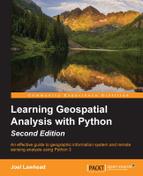The book starts with a background on geospatial analysis, offers a flow of techniques and technology used, and splits the field into its component specialty areas, such as Geographic Information Systems (GIS), remote sensing, elevation data, advanced modeling, and real-time data. The focus of the book is to lay a strong foundation in using the powerful Python language and framework in order to approach geospatial analysis effectively. In doing so, we'll focus on using pure Python as well as certain Python tools and APIs, and using generic algorithms. The readers will be able to analyze various forms of geospatial data that comes in and learn real-time data tracking and how to apply this to interesting scenarios.
While many third-party geospatial libraries are used throughout the examples, a special effort will made by us to use pure Python, with no dependencies, whenever possible. This focus on pure Python 3 examples is what will set this book apart from nearly all other information in this field. This book may be the only geospatial book using Python 3 on the market currently. We will also go through some popular libraries that weren't in the previous version of the book.
Chapter 1, Learning Geospatial Analysis with Python, introduces geospatial analysis as a way of answering questions about our world. The differences between GIS and remote sensing are explained. Common geospatial analysis processes are demonstrated using illustrations, basic formulas, pseudo code, and Python.
Chapter 2, Geospatial Data, explains the major categories of data as well as several newer formats that are becoming more and more common. Geospatial data comes in many forms. The most challenging part of geospatial analysis is acquiring the data that you need and preparing it for analysis. Familiarity with these data types is essential to understand geospatial analysis.
Chapter 3, The Geospatial Technology Landscape, tells you about the geospatial technology ecosystem that consists of thousands of software libraries and packages. This vast array of choices is overwhelming for newcomers to geospatial analysis. The secret to learning geospatial analysis quickly is understanding the handful of libraries and packages that really matter. Most other software is derived from these critical packages. Understanding the hierarchy of geospatial software and how it's used allows you to quickly comprehend and evaluate any geospatial tool.
Chapter 4, Geospatial Python Toolbox, introduces software and libraries that form the basis of the book and are used throughout. Python's role in the geospatial industry is elaborated: the GIS scripting language, mash-up glue language, and full-blown programming language. Code examples are used to teach data editing concepts, and many of the basic geospatial concepts in Chapter 1, Learning Geospatial Analysis Using Python, are also demonstrated in this chapter.
Chapter 5, Python and Geographic Information Systems, teaches you about simple yet practical Python GIS geospatial products using processes, which can be applied to a variety of problems.
Chapter 6, Python and Remote Sensing, shows you how to work with remote sensing geospatial data. Remote sensing includes some of the most complex and least-documented geospatial operations. This chapter will build a solid core for you and demystify remote sensing using Python.
Chapter 7, Python and Elevation Data, demonstrates the most common uses of elevation data and how to work with its unique properties. Elevation data deserves a chapter all on its own. Elevation data can be contained in almost any geospatial format but is used quite differently from other types of geospatial data.
Chapter 8, Advanced Geospatial Python Modeling, uses Python to teach you the true power of geospatial technology. Geospatial data editing and processing help us understand the world as it is. The true power of geospatial analysis is modeling. Geospatial models help us predict the future, narrow a vast field of choices down to the best options, and visualize concepts that cannot be directly observed in the natural world.
Chapter 9, Real-Time Data, examines the modern phenomena of geospatial analysis. A wise geospatial analyst once said, "As soon as a map is created it is obsolete." Until recently by the time you collected data about the earth, processed it, and created a geospatial product, the world it represented had already changed. But modern geospatial data shatter this notion. Data sets are available over the Internet which are up to the minute or even the second. This data fundamentally changes the way we perform geospatial analysis.
Chapter 10, Putting It All Together, combines the skills from the previous chapters step by step to build a generic corporate system to manage customer support requests and field support personnel that could be applied to virtually any organization.
